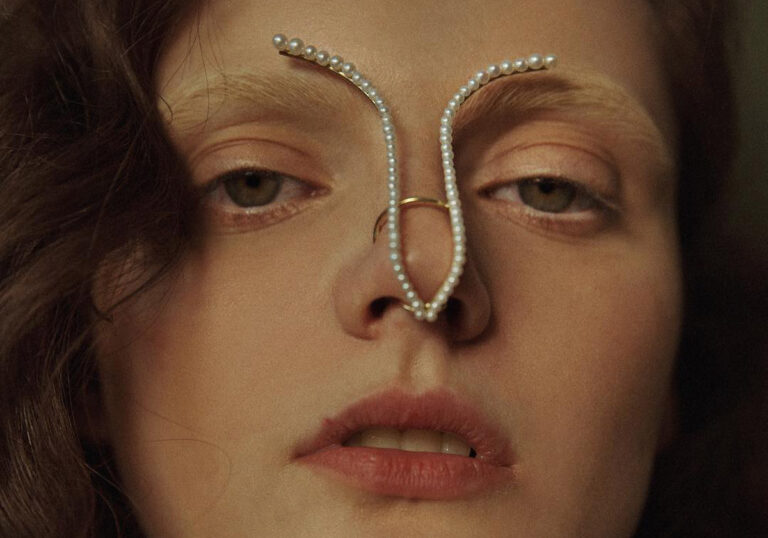Nose cuffs are here to cure your commitment issues once and for all
What do bangs, eyebrow cuts and dermaplaning have in common? They all take 3am courage—fuelled by hours of semi-legit research on TikTok and YouTube—to pull off in a dingy dorm bathroom. But what about those beauty commitments we undertake in broad daylight? I’m talking tattoos and piercings, among other high-risk fads. Take all the time you need to trace your fingers over the battle scars left by your 2015 nose piercing because a new facial accessory is on the horizon as we speak. Introducing the whimsical and zero-fuss world of nose cuffs.
What are nose cuffs?
Are you someone who wants tattoos and money pieces one minute, and wolf cuts and belly button piercings the next? What about your tenth grade curiosity as to what you would look like with a septum ring? Much like temporary tattoos and magnetic piercings, nose cuffs are a nifty way to both pull off and test drive a piece of body art without the actual commitment. At this point, you’re probably wondering ‘Oh, those $1 clip-on rings are back’. Well, the concept is. But your local nose candies just underwent a gen Z glow-up no one saw coming.
Available in the wildest shapes and designs, faux nose cuffs of 2021 are a statement—minus the bloodshed. According to Refinery29, the peak in demand for the accessory hints at a greater need for us to embrace maximalism after lockdowns. “Naturally, after the concentrated period of time that we spent hyper-focused on our faces in Zoom calls, it’s no wonder that accessories of the face are shining again,” the publication added while interviewing Celest Salgado, a Brooklyn-based artist who has been creating dreamy nose cuffs—ranging from exquisite designs to elaborate bridges featuring chains and charms.
The comments section under Salgado’s TikToks are digital proof of gen Z’s shifting preferences to the dramatic and zero-commitment face accessory. “As I’ve progressed, I’ve come to notice it’s my more unconventional shapes that people seem to gravitate towards,” she said, highlighting how unique and whimsical shapes, in particular, tend to resonate with her audience. “I think people really like the idea that no one piece is the same as the next.”
@scor9io When I learn how to make other designs and get stiffer wire it’s OVER! #diy #😎✌🏽
♬ CALL ME BY YOUR NAME BY LIL NAS X - not lil nas x
Just like knotless braids gaining traction over the pandemic, nose cuffs are often questioned on their cultural significance. Part of traditional rituals worldwide, the definition of what a nose ring means to a wearer depends on the region and belief system they were brought up in. With origins dating back to 1500 BCE, the accessory often marks a critical moment in someone’s life—such as entering adulthood or getting married.
For Salgado, an important element of her work is to ensure that she remains open to cultural boundaries. “I’m aware that there is some facial jewellery that has significant cultural meaning such as the nose chain but I do not, nor do I plan on making those,” she clarified in one of her videos, now at 82,000 views and counting. “My designs are based off of my own paintings and I made them because I don’t have an actual nose piercing but really wanted something to emulate it!” After extensive research, the artist is thereby ensuring that her designs do not appropriate other cultures and remain uniquely hers. With TikTok users dubbing her pieces as the future, it’s safe to say that the whimsical accessory has got the gen Z seal of approval.
A doubled-edged accessory
Apart from being a safer and often comfier option than the real deal, faux nose cuffs save users from the pain and roller-coaster trauma associated with the typical healing process of nose cartilages. Such tissues are essentially slower at self-healing, given the fact that there is less blood in the area due to its specific cellular structure. While some rings use magnets to help stick onto the nostril walls, the most common are designs that adhere to the natural curves of the nose without any further aid. These can be inserted and tightened until it appeases your anxiety of them falling off after you head out the door.
This brings us to a concerning standstill regarding the materials that are used to make the accessory in the first place. Considering their price range, faux cuffs are generally made of materials inferior to those used in regular piercing jewellery. The problem here is that the metals in their composition may trigger allergic reactions and irritations owing to little tissue tolerance, particularly in moist areas like the nostrils.
“It’s better if the fake nose rings you purchase are made of high-quality materials such as stainless steel, titanium or bioplast, since they are highly hypo-allergic even in the case of an existing bruise inside of the nose,” noted Streetdirectory.com, adding how it’s extremely concerning if you decide to insert a faux ring into a freshly pierced area—which only adds to the risk of developing an infection. “Nevertheless, try not to use any form of jewellery if you have nose ulcerations or herpes lesions as you may aggravate them.”
Keeping this in mind, feel free to embrace the versatility nose cuffs have to offer as yet another medium of expression. Meanwhile, brace yourself to see more artists exploring the potential these nose candies have to offer—well into 2022 and beyond.





